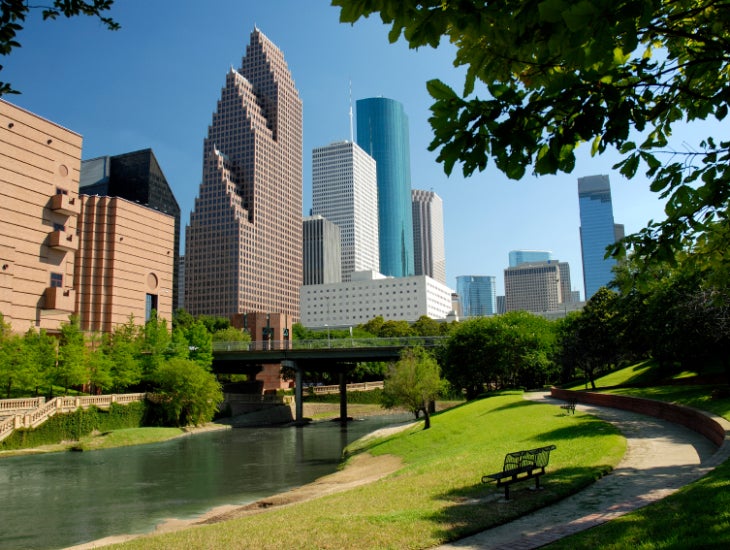Houston goes by many nicknames, including some not-so-pleasant ones you may have invented during this triple digit heat, but Bayou City remains a popular choice and one that truly reflects the city’s geography. Buffalo Bayou, perhaps Houston’s most well-known bayou and the site where the city was founded, has always been a major influence on Houston industries and is now the focus of a major park development.
In contrast to these events highlighting the bayou, there have also been times when Houstonians would rather abuse or ignore these same waterways. This fall learn more about our “love-hate” relationship with Houston’s bayous in “Buffalo Bayou: Houston’s Past, Present and Future.”
Jim Parsons, director of special projects for Preservation Houston, will share insights into Buffalo Bayou’s role in the development of Houston since the very beginning in this multi-instructor course. We recently had the opportunity to ask Mr. Parsons some questions about the course and his involvement in Houston history.
Why are you interested in Houston history?
First of all, I think Houston has a fascinating history. So many interesting things have happened here, and the stories of the people who shaped the city are really interesting, too — we've had some real characters here over the years. On top of that, Houston isn't always the best at respecting or promoting its history, so there's often a sort of element of surprise in studying the past. So many stories just aren't known or talked about.
What is your personal relationship to Houston – did you grow up here?
I grew up nearby, in Baytown. My family has been here for a while, though, and my parents were really good about driving my brother and I around all parts of the city when we were young, telling us about what things were and what happened where. So I grew up with an appreciation of the city and a curiosity about it.
How did you become involved with Preservation Houston?
I started out as a volunteer docent with Preservation Houston's Architecture Walks Program. I attended one of the monthly walking tours and realized that there was a group of people who were interested in the same things I was, and I was hooked. After a few years as a volunteer, I was lucky enough to be hired as part of the full-time staff.

Can you share a short anecdote about the development of Houston and it’s neighborhoods along the Bayou?
This is kind of an inappropriate story, but I think it's a great one (and it makes us happy we're living in 2015 rather than a hundred years ago). Around the turn of the 20th century, Buffalo Bayou was horribly polluted by all kinds of things — sewage, industrial runoff, dead animals, graveyards. The Houston Water Works Company, which provided drinking water to the city, was supposed to be getting its water from artesian wells, but Houstonians kept noticing that their water was dirty; they called it “tar water.” Eels and fish were found in water pipes, and one day a passer-by caught catfish jumping out of a broken water main, so it was pretty clear that the Water Works Company was actually pumping drinking water right out of the bayou. One observer at the time noted that there were nearly a hundred churches in town, but a really horrible water system. “While people of Houston were admirably equipped for living in Heaven, they were rather poorly equipped for living in Houston,” he wrote. Luckily for all of us, the city took the water department over, and things have been a lot better since then.
Is there an urban legend about Houston’s bayous you want to dispel?
Well, I'm looking at the bayou from the standpoint of urban development, so that's what my urban legend has to do with. Downtown Houston is laid out at an angle, so the streets don't run directly north/south and east/west. I've heard people give all kinds of reasons for that, including that the Allen brothers wanted to pay homage to their home state of New York by pointing the city in its direction. The truth is that the Allens and their surveyors laid the city out with streets running parallel and perpendicular to Buffalo Bayou as it passed the townsite, which accounts for the angle. (Plus, if you trace a line northeast from Houston, you find that the city actually points toward Flint, Michigan. No disrespect to Flint, but I don't think the Allen brothers meant anything by that.)
What do you think is the greatest misunderstanding about Houston’s bayous?
I'm not sure if this really qualifies as a misunderstanding, but I think we haven't always done a good job of realizing the full potential of the bayous. Back in 1913, a planner named Arthur Comey recommended developing land alongside the bayous into a citywide park system, which would have been fantastic. Instead, many of the bayous were eventually paved and turned into giant drainage ditches — efficient, but not very friendly. So I think the misunderstanding might be that our bayous have to be utilitarian, ugly things. That couldn't be farther from the truth, as the park development along Buffalo Bayou downtown has showed us. And the good news is that there's a new comprehensive parks plan based on the bayous, so we may start seeing more and more of them as assets rather than as ditches.
Do you think native Houstonians and non-natives will get something different out of your class?
I hope that everyone will get a better understanding of how Buffalo Bayou in particular shaped Houston's development and was a major force in the way the city came together, at least in the early years. We've lost that to some extent as the city has sprawled, but for a long time Houston was really oriented east and west, following the course of the bayou. Natives, I think, will be surprised to see how far the bayou has come, and non-natives may be able to understand a little bit better why Houston's bayous are so special to us.
Whether you are a Houston history buff or a recent transplant curious about the waterways you commute over, join us on Monday, September 28 for “Buffalo Bayou: Houston’s Past, Present and Future,” to learn more about the bayous that have shaped our city. You may even learn some new nicknames for our unique locale.

